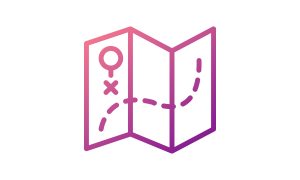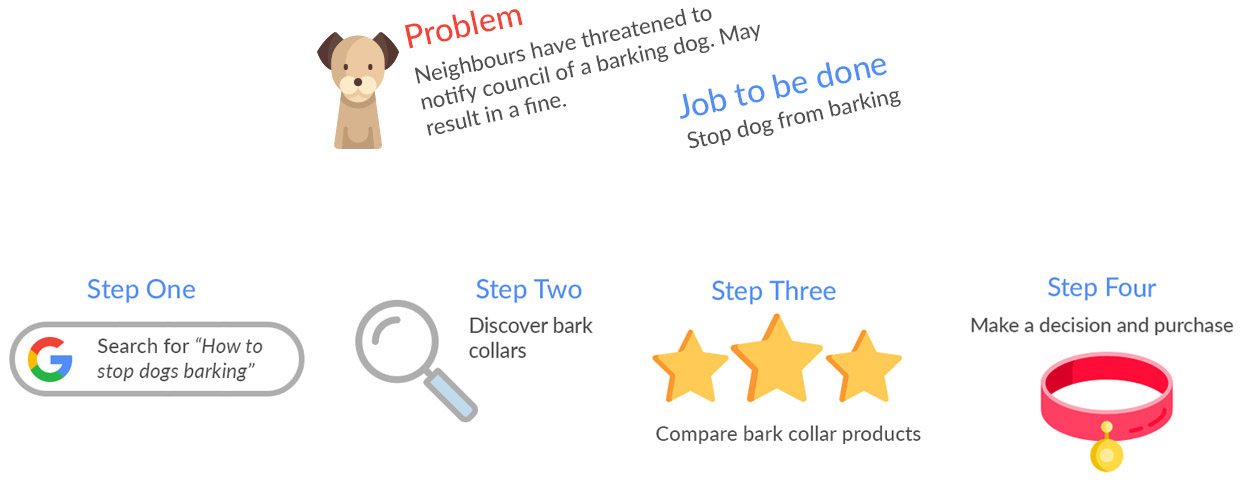All purchases, whether it’s a product or a service, begin with a job to be done. After the purchaser identifies this job to be done, they embark on a journey to complete it.
Some customer journeys are short and simple, while others are longer and more complex.
It is our job as marketers to guide customers through that journey, providing information and value every step of the way to ensure the best outcome for that customer (i.e. your product or service!)

Theodore Levitt said it best when he stated that “people do not want a quarter-inch drill, they want a quarter-inch hole.”
So often I see salespeople and marketers relentlessly driving their product (a quarter-inch drill), when they should be focused on addressing the customer’s real need (a quarter-inch hole).
Show the customer that you truly understand their needs and, in return, they will see value in your product or service.
Mapping the customer journey
We can do this by identifying steps in the customer journey and creating touch points for each step to provide value to the customer and guide them through the process.
It is important to utilise multiple marketing channels for these touch points as consumers look to many different places, online and offline, throughout their journey.
One channel may work perfectly for a particular point in the journey but poorly at another time – make sure you test and optimise your campaigns to account for this.
Say your product is an anti-bark collar for dogs. You can start your customer journey research by looking at purchase behaviour online and offline.
You may even have the opportunity to survey past purchasers to get a deeper understanding of their motivations, time frames and decision-making methods.
Once you have completed your research, you may end up with a journey like this:
This particular customer journey is relatively quick and simple – it could take place in less than a week. This is important to consider when creating your touch points.
Another consideration is the motive behind each action so that you can create targeted content to have the most impact at each step.
So once you have identified your ideal customer’s job to be done and mapped out their typical journey, how do you guide them through and demonstrate your value?
Well, let me introduce you to my good friend, email marketing.
Create touchpoints through automation
Creating touchpoints is easy with the help of a powerful marketing software platform. With a platform such as Vision6, there are tools to help you at each step of the customer journey such as:
- Web forms to capture potential customer information
- User-friendly email design tool and/or pre-designed email templates to choose from
- Automated emails and text messages triggered by specific website/email activity or engagement with your business
- Retargeting through AdWords integration
If we continue with the dog owner as an example, your touch points may look like this:
- AdWords and social media posts targeting people with barking dog issues
- Content on your website to help the customer learn more about their options. I.e. a blog article, “how to stop your dog from barking” and anti-bark collar products available to purchase online or in-store
- Webform to sign up to the newsletter for dog owners
- Shopping cart sign up (with a tick box to receive the newsletter)
- “Thank you for signing up” email
- Email invitation to an upcoming event that your business is holding in-store, “how to train your dog to stop barking”
- Follow up email with more information and product comparison, linking back to your website and products
- AdWords and social media remarketing campaign to guide the customer back to your website
- A “forgotten something?” email if the customer has selected products but not made a purchase
- “Need more information?” email with link to relevant blog articles and access to customer support
- Promotional email or SMS offering a deal on your product
The potential customer may make their purchase at any time along this journey. You can set up the automation series to change direction once the potential customer has made a purchase or any other trigger that indicates that they have become a customer.
The customer journey after a purchase
An automation series to support the customer journey towards their first purchase is often called an onboarding series. There are plenty of ways that you can stay in touch with a customer after they have purchased your product or chosen your service.
Say the dog owner has purchased an anti-bark collar. You could set up an automation series for customers who have purchased products (segmenting these as much or as little as you like), which may look like this:
- “Purchase confirmation” email upon purchase
- “Your product is on its way!” email once the product has left the warehouse/store
- “How is it going?” email once the product has been received and suggestion of other products that may be of interest or a request to review your product online (great for SEO!)
- Monthly company newsletter with valuable content linking back to your website
- Email notifications of new products, promotions and/or events
There are so many possibilities with automation and the best results occur when you truly understand your customer’s journey.
Ready to give this a try? You can sign up for a Free Trial with Vision6 and start your automation series today.
Our expert customer support team is standing by to assist you in getting started and is always available to help with any difficulties you may encounter along the way.





